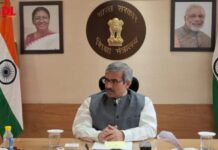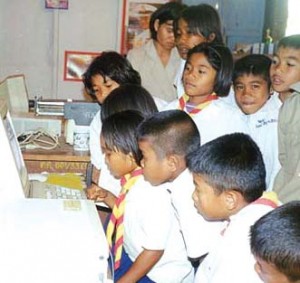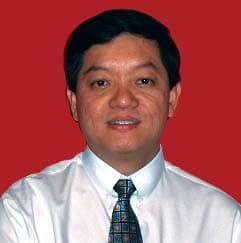 Barriers to e-learning in Asia Pacific
Barriers to e-learning in Asia Pacific
“The term e-learning is most
frequently used to refer to computerbased training which incorporates technologies that support interactivity beyond that which would be provided by a single computer. Elearning,
therefore, is an approach to
facilitate and enhance learning through, and based on, both computer and communications technology. Such devices can include personal computers, CD-ROMs, digital television, personal digital assistants (PDAs) and mobile phones. Communications technology enables the use of the Internet, email,
discussion forums, collaborative software, classroom management software and team learning systems.” UNESCO research (http:// www.unescobkk.org/
index.php?id=1807) has indicated that many countries in the Asia- Pacific region do not use ICT and e-learning to their full potential in enhancing the quality of teaching and learning. There are many barriers to be overcome, which can broadly be classified into three main categories: • Technical – lack of infrastructure, equipment and connectivity; • Pedagogical – lack of teacher
training in ICT integration into pedagogical practice; Institutional – lack of
requirements or recognition for use of ICT in the curriculum and low/no support from management and ministries. Thus, to fulfill the potential of ICT as
a tool for enhancing teaching and learning, ICT must be fully integrated into both pedagogy and school administration, which requires a cognitive shift on the part of teachers, educators, curriculum developers, administrators and policy-makers. In many cases for this process to be enabled, the private sector must be engaged to reduce the cost of infrastructure and connectivity for educational institutions.
 SchoolNet project:
SchoolNet project:
a backdrop Taking into consideration the above barriers, the UNESCO SchoolNet project, subtitled “Strengthening ICT in Schools and SchoolNet Project in ASEAN Setting”, was initiated in recognition of the need to assist
teachers in integrating ICT into teaching, and facilitate participation of teachers and students in the Asia- Pacific region in SchoolNet telecollaboration activities. The SchoolNet project engages target audiences at all levels of the school system in order to bring about change in the use of ICT: officials in
Ministries of Education; SchoolNet managers; technical staff; teacher trainers and teachers themselves. SchoolNet promotes effective use of information and communication technologies (ICT) in learning through supporting connection
of schools to the Internet and by creating a network of schools. This network is envisaged as a means to build connections among students, teachers and schools; share information and resources; and prepare learners for nowledge-based societies. SchoolNet also encourages the creation of locally-relevant and high-quality educational resources
The UNESCO SchoolNet project aims to:
• Explore and demonstrate how ICT can be used in schools to improve the quality of education and better prepare youth for the demands of knowledge societies; · Test innovative models of ICT use and of ICT-based teacher education; • Encourage use of ICT in teaching-learning and materials
development in schools and other educational contexts; • Improve connectivity and expand access to the wealth of educational resources
available via the Internet; • Establish and promote SchoolNet in the Asia-Pacific region. The project was launched in July 2003 and focuses on three subject areas, which are common to all schools in the region: languages, mathematics and science. Curriculum topics were mapped, and where overlap was identified, activities were designed and launched for schools to explore
together via online learning circles (Learning Circles: Virtual Communities for Elementary and Secondary Schools http://lrs.ed.uiuc.edu/ Guidelines/Riel-93.html) in the Bridges to Learning initiative(Bridges to Learning http://www.unescobkk
Exploring the use of ICT
Early stages of the project involved researching and documenting eight components of ICT integration in ducation in a case study of several Asia-Pacific countries (Indonesia, Malaysia, Philipppines, Singapore, South Korea and Thailand). The components werebroader environmental context;
policy and regulatory environment; management and financing; ICT in schools – policy, vision and strategy; technology infrastructure and connectivity; curriculum, pedagogy and content development; professional development; monitoring and evaluation. These components provided the key foundation and framework in setting up ICT for education projects, and gave insight and expertise for the further development of the SchoolNet project. A synthesis of lessons learned (Integrating ICTs into Education: Lessons Learned Vol. 1 http://www.unescobkk.org/ fileadmin/user_upload/ict/e-books/ ICTLessonsLearned/ICT_ integrating_education.pdf) was published, which supports the development of tools and blueprints to guide policy formulation and programme improvements.
Encouraging use of ICT in teaching-learning and materials  development in schools
development in schools
To enable teachers to develop and use ICT materials for teaching and learning, the SchoolNet project developed a framework for training teachers, and then implemented the framework with teachers from the SchoolNet pilot schools. Before working directly with teachers, a number of academics, consultants
and other pedagogical experts came together in a workshop (ICT-based Lesson- and Material-Development Workshop http://www.unescobkk. org/index.php?id=1412) to develop he detailed framework for systematically integrating ICT into cience, mathematics and language teaching. This workshop also defined strategies and techniques for training teachers in the creation of ICT-based lessons and materials. It became clear in the project definition phase that teachers in Cambodia, Laos, Myanmar and Viet Nam required basic skills in ICT before moving on to more advanced and innovative approaches. A 10-day sub-regional training course was therefore organised for teachers from
pilot schools in these countries. Two training workshops for teachers on using ICT for teaching science, maths and languages were then subsequently organised on the basis of the strategies developed, in Hanoi (Training on the Use of ICT in Teaching Mathematics, Science, and Languages for Cambodia, Laos, Vietnam http://www.unescobkk.org/ index.php?id=3306) and Penang
(Training on the Use of ICT in Teaching Mathematics, Science, and Languages for Indonesia, Malaysia, Philippines and Thailand http://www.unescobkk.org/
index.php?id=3305). The Hanoi workshop targeted Cambodia, Laos, Myanmar and Viet Nam (CLMV), while the Penang workshop focused on Indonesia, Malaysia, Thailand and Philippines (IMTP); separate workshops were organised to enable focused training appropriate to the specific needs of teachers from the different subregions. For instance, many teachers in the CMLV countries had required additional basic ICT skills training, while the IMTP teachers required more training in ICT integration into pedagogy. Common more advanced training was given later regarding web content (see the section below ‘Improve connectivity and expand access to the Internet’). As a result of the training, the teachers at the pilot schools were able to develop their own ICT-based materials, which were used within their own classrooms and also shared on a national level. 12 teachers from the pilot schools in Thailand, Viet
Nam, Malaysia and Myanmar were rewarded for the ICT materials development by being invited to the nnovative Teachers Conference2 where they displayed lesson plans and associated materials that they had created. More than ICT-based 40 lesson plans are produced in each pilot country. The National coordinators of SchoolNet are currently collecting and sharing lesson plans developed in schools across the pilot group; it is hoped these lesson plans and resources can be re-used by other teachers, and will inspire them to also
create their own.
The project was launched in July 2003 and focuses on three subject areas, which are common to all schools in the region: languages, mathematics and science. SchoolNet activities were piloted in 24
schools in the eight participating countries Expanding access to the Internet In the SchoolNet project, the eight countries involved were classified into two groups:
• Countries which already had established national SchoolNets and equipped some schools with computer labs and Internet connectivity – IMTP; • Countries, which lacked national SchoolNets and had low levels of equipment in schools, and no connectivity – CLMV. The SchoolNet project’s infrastructure
work thus focused on the second group of countries, CLMV, in order to enable them to collaborate with other schools in the project located in the IMTP countries. This was achieved through the following actions: • Funding for national SchoolNets in CMLV – SchoolNet coordinators received budget to purchase a good quality web server to host SchoolNet services and fund staff (SchoolNet managers) to oversee the SchoolNet activities; • Distribution of donated computers in CMLV – a South Korean organisation donated many second hand computers, which were offered to CMLV schools; • Funding for schools in CMLV – each pilot school received a grant to purchase 4-5 computers and cover the costs of Internet connectivity. In addition, a regional training course (Regional Training course of Website Managers, teachers and SchoolNet technical Personnel on the Development and maintenance of SchoolNet http://www.unescobkk. org/index.php?id=2272) was held for teachers, SchoolNet managers and technical personnel. This course enabled them to develop web content for school websites, administrate the UNESCO SchoolNet and gain knowledge of maintenance and troubleshooting of the national SchoolNet systems. NECTEC is currently arranging follow up visits to the pilot schools, to ensure they have the equipment configured to their satisfaction, and will offer further training and technical support where necessary.
Promoting SchoolNet in the Asia-Pacific region
To ensure the establishment of national SchoolNets website and services and to begin the development of the regional SchoolNet website and services, a regional workshop (Report on SchoolNet Regional Workshop on the Creation of the national and regional SchoolNet http://www.unescobkk.org/fileadmin/ user_upload/ict/schoolnet/ documents/SchoolNet_-_Report _Regional_Planning_Workshop_4- 6_Apr05.pdf) was held on the theme ‘Creation of National and Regional SchoolNet’. SchoolNet national coordinators and SchoolNet managers all participated in the workshop to develop a master plan for the creation of the regional SchoolNet website; identify roles and responsibilities of regional and national SchoolNets; develop policies, rules and guidelines for participation; and to gain knowledge about telecollaboration and activity monitoring. In this area, the SchoolNet project is still in progress, and aims to demonstrate a prototype version of the regional SchoolNet website at the final workshop planned for June 2006 in Bangkok, Thailand. The goal of the
regional website is to demonstrate the activities and strength of the SchoolNet project, but also to put in place a sustainable platform for teachers to use for telecollaboration. The SchoolNet project is an ambitious and visionary project to tackle in the Asia Pacific region, bearing in mind the many obstacles in all domains. At many times, progress was difficult, and extensive work and training was needed to achieve the objectives of the project. However, so far, the results seem positive, and the success of the second round of the Learning
Circles is particularly encouraging. A formal evaluation procedure has been designed and will shortly be implemented to understand the full impact of the project; the regional SchoolNet site will soon be launched and a final workshop for SchoolNet participants for sharing lessons learned will be held in June 2006








 In this article we introduce a new concept – university ICT4D – that refers to the university as a producer of ICT4D knowledge and engaged actor in ICT4D practice – understood as the teaching, research and outreach activities of universities that link ICTs to the development needs of their communities and advance the transition to the knowledge society. Experience has shown that successfully leveraging Internet technologies for economic, social and political change demands new models and new technologies, and depends upon multi-disciplinary and multisectoral approaches. In most developing world contexts, complex problems are paired with limited institutional capacity and scarce funds, making essential the efficient and creative use of available resources. One powerful and oftenoverlooked piece of this puzzle is academia, which has substantial relevant capabilities to offer as investigator, consultant, educator, convener, evaluator and more. Indeed to perform these functions is to achieve the very mission of the university. When speaking of ICTs, we know universities as producers of ICT skills and knowledge in areas ranging from computer literacy to high-end programming. We posit, however, that while there are real barriers to university engagement in ICT4D and the broader revolution in cademia it requires or fosters, there is already more happening than many of us realise. As the following examples briefly illustrate, there are a number of less well-known but critically important ways that developing world universities are already making strides towards teaching, conducting research and integrating outreach programs in this field of ICT4D. The La Salle Institute of Governance (LSIG) at De La Salle University in the Philippines is a research and training institution that aims to produce new knowledge, strategies and tools that promote transparent, accountable, participatory, and effective governance. Recognising the growing interest in ICT, in 2002 political science professor Francisco Magno and his colleagues began to study ICT’s contribution to good governance. From this modest start, today they boast an active egovernance program that has a wide range of activities cutting across teaching, research, and community engagement. LSIG conducts workshops for local and national policy makers; produces a quarterly magazine for the League of Municipalities; hosts conferencessuch as Civil Society and Rights- Based Governance; produces research studies on such topics as “Good Governance and Anti- Corruption: A Term-End Performance Assessment”; introduces new courses into the university general curriculum and specialised courses for graduate students; and maintains partnerships with governmental and nongovernmental organisations. From a donor perspective, there are numerous organisations available to implement ICT4D programs across any fields – rural development, health services, e-government, women empowerment, policy reform, NGO capacity building – but surprisingly little academic quality research that analyses the results and implications for future efforts and policies. There are many case studies that are closer to collections of anecdotes written to showcase success, rather than the more painfully learned (and earned) lessons. What has been missing is high-quality, comparable, analytically rigorous, and dispassionate research and evaluation that will allow everyone to learn from past experiences and improve future program designs and implementations. As a Philippine colleague told us, “if you ever find someone doing research on programimpact here, it’s someone rom another country.” This situation exacerbates deeper-seated problems, impeding our understanding of the interactions between ICT and poverty alleviation, business generation, improved governance, gender equality and the other issues we care about – it’s essential for developing world researchers to help develop the supporting ideas and methods. In the area of teaching, we encountered widespread agreement that every country needs professionals in government, industry and civil society who understand the dynamics and challenges of ICTenabled socio-economic development. Unfortunately, relatively few developing world universities are adequately preparing students with the knowledge and skills for crafting better telecommunication policies, developing sustainable telecenters that meet the needs of underserved communities, or promoting effective use of ICT by small and medium enterprises. This is made even more ifficult due to barriers to elective coursework, cross-listed courses, and ther national and institutional policies that limit capacity and incentives for new pedagogical and programmatic approaches. Finally, in the outreach arena, few developing universities engage their students and faculty meaningfully with their communities. Developing educational and beneficial internships, community service, course projects and other programs that offer university expertise to local communities is a complicated affair. Yet these forms of engagement promise both substantial real-world learning opportunities for the university and real results for the communities in which they reside. Until universities effectively engage their communities, both groups will forego valuable fruits that would help advance the university mission and promote social well-being challenges? Many bservers ncluding people within academia) have deep reservations, ranging from doubts as to whether universities should take on these issues in the first place, to dismissing universities as being incapable of fulfilling these expectations. Critics claim, rightly in many cases, that universities are ossified institutions, largely incapable of the internal reform and innovation needed to make them more relevant to the changing needs of society. Or, they point to external constraints such as higher education policies that, for example, have a five-year process for introducing a new course, hardly the appropriate environment for curricular innovation. Or, they comment on systemic challenges such as disciplinary rigidities that make it difficult to conduct interdisciplinary work. There is general agreement among ICT4D scholars that one needs to bring a diversity of disciplinary tools to this field, yet universities and the journals where scholars need to publish in order to receive promotions reinforce the very disciplinary boundaries we need to overcome. Indeed, getting technologists to work effectively with social scientists and the professional disciplines is a central question of ICT4D research.
In this article we introduce a new concept – university ICT4D – that refers to the university as a producer of ICT4D knowledge and engaged actor in ICT4D practice – understood as the teaching, research and outreach activities of universities that link ICTs to the development needs of their communities and advance the transition to the knowledge society. Experience has shown that successfully leveraging Internet technologies for economic, social and political change demands new models and new technologies, and depends upon multi-disciplinary and multisectoral approaches. In most developing world contexts, complex problems are paired with limited institutional capacity and scarce funds, making essential the efficient and creative use of available resources. One powerful and oftenoverlooked piece of this puzzle is academia, which has substantial relevant capabilities to offer as investigator, consultant, educator, convener, evaluator and more. Indeed to perform these functions is to achieve the very mission of the university. When speaking of ICTs, we know universities as producers of ICT skills and knowledge in areas ranging from computer literacy to high-end programming. We posit, however, that while there are real barriers to university engagement in ICT4D and the broader revolution in cademia it requires or fosters, there is already more happening than many of us realise. As the following examples briefly illustrate, there are a number of less well-known but critically important ways that developing world universities are already making strides towards teaching, conducting research and integrating outreach programs in this field of ICT4D. The La Salle Institute of Governance (LSIG) at De La Salle University in the Philippines is a research and training institution that aims to produce new knowledge, strategies and tools that promote transparent, accountable, participatory, and effective governance. Recognising the growing interest in ICT, in 2002 political science professor Francisco Magno and his colleagues began to study ICT’s contribution to good governance. From this modest start, today they boast an active egovernance program that has a wide range of activities cutting across teaching, research, and community engagement. LSIG conducts workshops for local and national policy makers; produces a quarterly magazine for the League of Municipalities; hosts conferencessuch as Civil Society and Rights- Based Governance; produces research studies on such topics as “Good Governance and Anti- Corruption: A Term-End Performance Assessment”; introduces new courses into the university general curriculum and specialised courses for graduate students; and maintains partnerships with governmental and nongovernmental organisations. From a donor perspective, there are numerous organisations available to implement ICT4D programs across any fields – rural development, health services, e-government, women empowerment, policy reform, NGO capacity building – but surprisingly little academic quality research that analyses the results and implications for future efforts and policies. There are many case studies that are closer to collections of anecdotes written to showcase success, rather than the more painfully learned (and earned) lessons. What has been missing is high-quality, comparable, analytically rigorous, and dispassionate research and evaluation that will allow everyone to learn from past experiences and improve future program designs and implementations. As a Philippine colleague told us, “if you ever find someone doing research on programimpact here, it’s someone rom another country.” This situation exacerbates deeper-seated problems, impeding our understanding of the interactions between ICT and poverty alleviation, business generation, improved governance, gender equality and the other issues we care about – it’s essential for developing world researchers to help develop the supporting ideas and methods. In the area of teaching, we encountered widespread agreement that every country needs professionals in government, industry and civil society who understand the dynamics and challenges of ICTenabled socio-economic development. Unfortunately, relatively few developing world universities are adequately preparing students with the knowledge and skills for crafting better telecommunication policies, developing sustainable telecenters that meet the needs of underserved communities, or promoting effective use of ICT by small and medium enterprises. This is made even more ifficult due to barriers to elective coursework, cross-listed courses, and ther national and institutional policies that limit capacity and incentives for new pedagogical and programmatic approaches. Finally, in the outreach arena, few developing universities engage their students and faculty meaningfully with their communities. Developing educational and beneficial internships, community service, course projects and other programs that offer university expertise to local communities is a complicated affair. Yet these forms of engagement promise both substantial real-world learning opportunities for the university and real results for the communities in which they reside. Until universities effectively engage their communities, both groups will forego valuable fruits that would help advance the university mission and promote social well-being challenges? Many bservers ncluding people within academia) have deep reservations, ranging from doubts as to whether universities should take on these issues in the first place, to dismissing universities as being incapable of fulfilling these expectations. Critics claim, rightly in many cases, that universities are ossified institutions, largely incapable of the internal reform and innovation needed to make them more relevant to the changing needs of society. Or, they point to external constraints such as higher education policies that, for example, have a five-year process for introducing a new course, hardly the appropriate environment for curricular innovation. Or, they comment on systemic challenges such as disciplinary rigidities that make it difficult to conduct interdisciplinary work. There is general agreement among ICT4D scholars that one needs to bring a diversity of disciplinary tools to this field, yet universities and the journals where scholars need to publish in order to receive promotions reinforce the very disciplinary boundaries we need to overcome. Indeed, getting technologists to work effectively with social scientists and the professional disciplines is a central question of ICT4D research.













